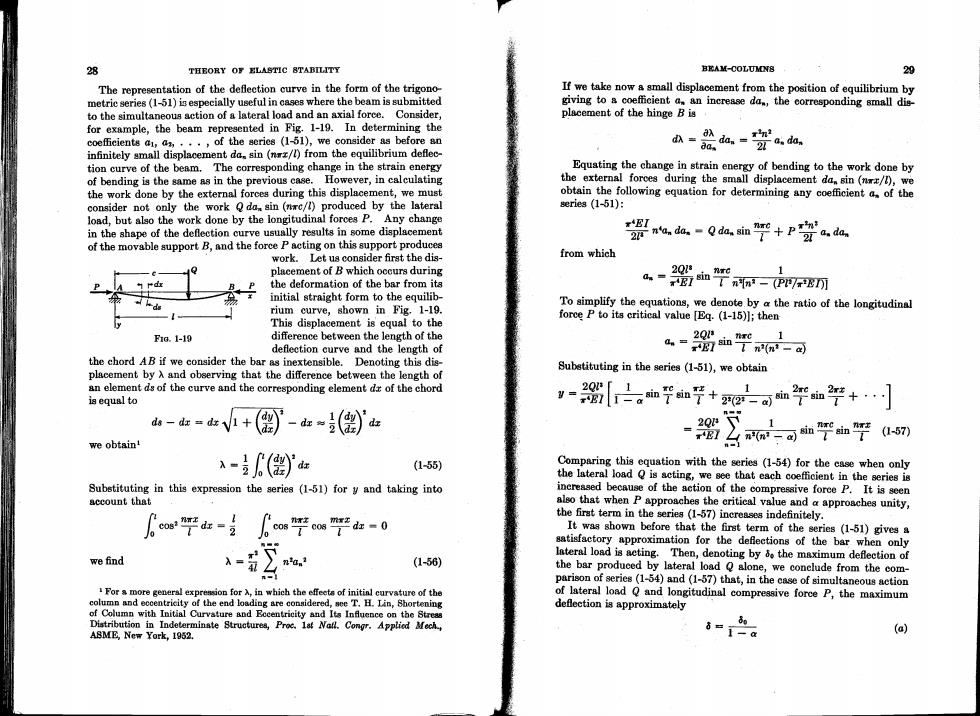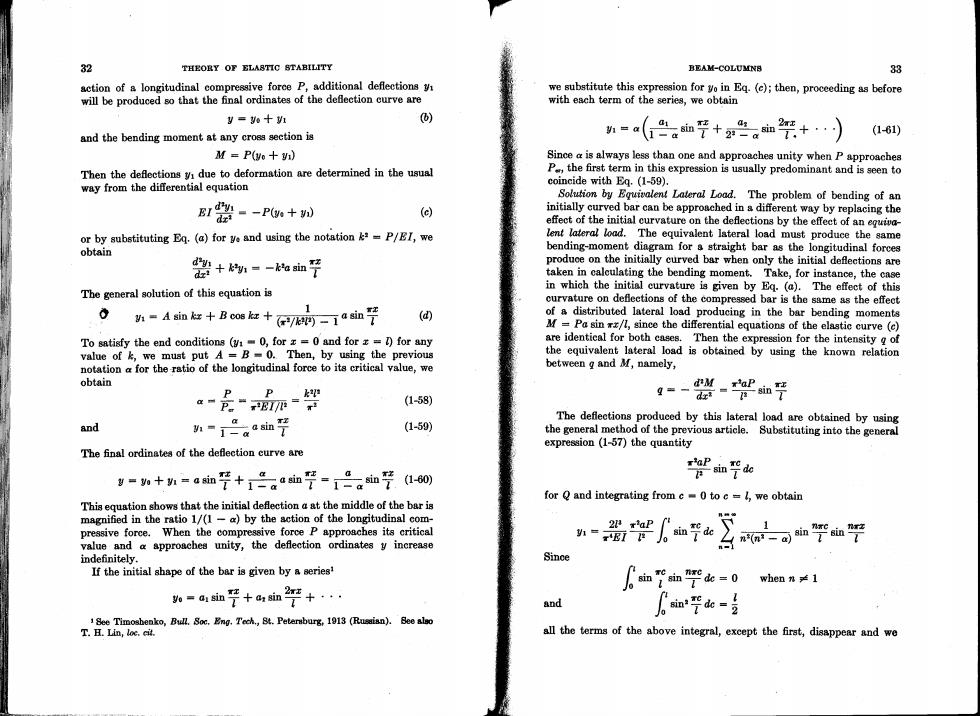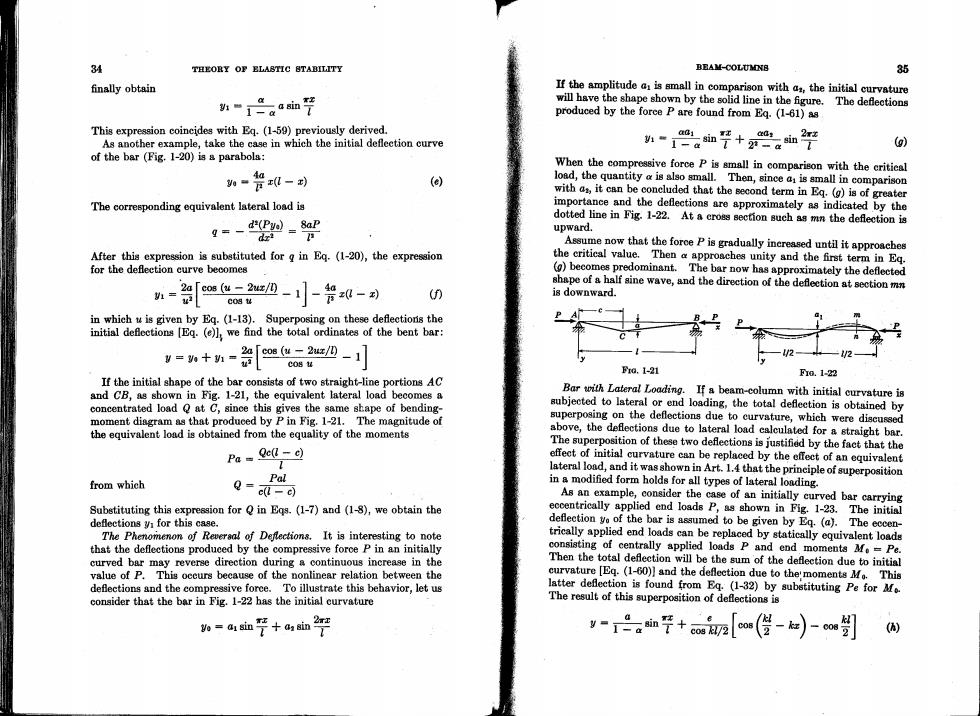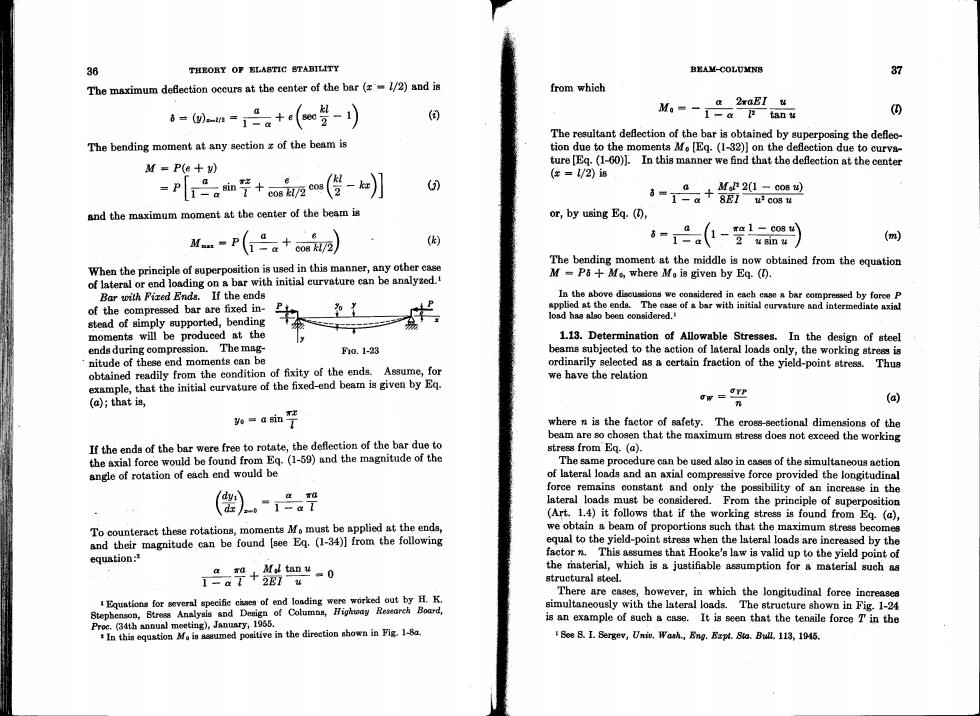
28 THEORY OF ELASTIC 8TABILITY BEAM-COLUMNB 29 The representation of the deflection curve in the form of the trigono- If we take now a small displacement from the position of equilibrium by metric series(1-51)is especially useful in cases where the beam is submitted giving to a coefficient a.an increase da.,the corresponding small dis- to the simultaneous action of a lateral load and an axial force.Consider, placement of the hinge B is for example,the beam represented in Fig.1-19.In determining the coe伍cients a,a,··,of the series(l-il),we consider as before an dh da.i infinitely small displacement da.sin (nrz/l)from the equilibrium deflec- das 2 a.da, tion curve of the beam.The corresponding change in the strain energy Equating the change in strain energy of bending to the work done by of bending is the same as in the previous case.However,in calculating the external forces during the small displacement da sin (nr/),we the work done by the external forces during this displacement,we must obtain the following equation for determining any coefficient a.of the consider not only the work Q da.sin(nxe/l)produced by the lateral series (1-51): load,but also the work done by the longitudinal forces P.Any change in the shape of the deflection curve usually results in some displacement a,a-0a,血T+P资aa EI of the movable support B,and the force P acting on this support produces work.Let us consider first the dis- from which placement of B which occurs during a-30 血平-Fgm 1 the deformation of the bar from its initial straight form to the equilib- rium curve,shown in Fig.1-19. To simplify the equations,we denote by a the ratio of the longitudinal This displacement is equal to the force P to its critical value [Eq.(1-15)];then F1G.1-19 difference between the length of the deflection curve and the length of 4-血平-司 the chord AB if we consider the bar as inextensible.Denoting this dis- placement by A and observing that the difference between the length of Substituting in the series(1-51),we obtain an element ds of the curve and the corresponding element dr of the chord 1 is equal to y=引2。血平如7+可血平血平+小 -=+图-( 2Q1 1 g7-司Tn平 (1-57) we obtain! na】 -(血 (1-55) Comparing this equation with the series(1-54)for the case when only the lateral load Q is acting,we see that each coefficient in the series is Substituting in this expression the series (1-51)for y and taking into increased because of the action of the compressive force P.It is seen account that also that when P approaches the critical value and a approaches unity, os"co"-0 the first term in the series(1-57)increases indefinitely. It was shown before that the first term of the series (1-51)gives a satisfactory approximation for the deflections of the bar when only we find ),nan2 (1-56) lateral load is acting.Then,denoting by &the maximum deflection of the bar produced by lateral load Q alone,we conclude from the com- parison of series (1-54)and (1-57)that,in the case of simultaneous action Fora more general expreasion for,in which the effeets of initinl curvature of the column and eccentricity of the end loading are considered,see T.H.Lin,Shortening of lateral load Q and longitudinal compressive force P,the maximum deflection is approximately of Column with Initial Curvature and Eccentricity and Its Influence on the Streas Distribution in Indeterminate Struetures,Proc.1at Nall.Congr.Applied Mech, ASME,New York,1952. 1一a (a)

30 THEORY.OF ELASTIC BTABILITY BEAM-COLUMNS 31 Thus the deflection 6 due to lateral load only is increased by the ampli- fication factor 1/(1-a)when an axial load is also present.This Since the curve in this case is symmetrical with respeet to the center of amplification factor was discussed previously in Art.1.7. the beam,the terms with even values of n do not appear in the series (c). Having determined the deflection curve [Eq.(1-57)]for the case of one The deflection at the middle is lateral load Q,we can,without difficulty,obtain the defleetions for any kind of lateral loading by using the principle of superposition.In the 6=(2-in=手 [2.0a+ (④ case of a uniform lateral load on a compressed bar,we substitute gde instead of Q in the series (1-57)and integrate this series by varying c If the couples at the ends are produced by compressive forces P applied within the limits of the loaded portion of the beam.If the load covers at both ends with the same eccentricity e,we put Pe instead of Mo in the entire span,the integration limits are 0 andand we obtain Eq.(d);then a-回血平 】 [。0a+…小 Again the series is a rapidly converging one and we can obtain the deflee- Again we have a rapidly converging series,and the first term gives a tion with sufficient accuracy by taking only the first term of the series. satisfactory approximation so that a formula analogous to Eq.(a) Thus can also be used in this case and the defection can be calculated by = 4ea multiplying the deflection 50,produced by lateral load alone,by the factor (1=a (e) 1/(1-a).This formula is very sccurate for small values of a.With an increase of a,the error of the approximate formula increases also and n the general case where M.and M are not equal,we can alwava approaches one-half of 1 per cent when P approaches its critical value. replace them by two equal moments M of the same sign,equal to By moving the load Q to the left support (Fig.1-19)and making c M+M3),and twoequal moments infinitesimally small,we approach the condition of bending of the bar M"of the opposite sign,equal to P 地a (M.-M).Only the first two mo- by a couple Qc applied at the left end.Substituting sin (nre/1)-nwe/Z ments produce deflection at the mid- into Eq.(1-57)and using the notation Qc-Ma,we obtain the following peries giving the deflection curve of a compressed bar bent by a couple dle.Hence,if compressive forces P are applied at the ends with the ec- at the end: F10.1-20 centricities e and ea,the deflection 2M1 () at the middle is obtained from Eq.(e)by substituting!(e+e)for e. y- 1.12.The Effect of Initial Curvature on Deflections.When a bar is n】 submitted to the action of lateral load only,a small initial curvature of If there are two moments M.and Ms applied at the ends,the deflection the bar has no effect on the bending and the final deflection curve is curve is obtained by superposing deflections produced by each of the obtained by superposing the ordinates due to initial curvature on the moments.Assuming,for instance,Ma=M=Mo and using Eq.() deflections calculated as for a straight bar.However,if there is an axial we obtain,for the case of two equal moments,the deflection curve force acting on the bar,the deflections produced by this force will be substantially influenced by the initial curvature. 1 Let us consider,as an example,the case in which the initial shape of EI the axis of the bar is given by the equation (see Fig.1-20) n一可咖到 2M: h=am受 (a) xEI Thus the axis of the bar has initially the form of a sine curve with a maxi- mum ordinate at the middle equal to a.If this bar is submitted to the -1,3 The eccentricities abould be taken poeitive when they result in positive bending moments at the ends,and negative in the reversed eaae

32 THEORY OF ELASTIC STABILITY BEAM-COLUMNB 33 action of a longitudinal compressive foree P,additional deflections y we substitute this expression for yo in Eq.(c);then,proceeding as before will be produced so that the final ordinates of the deflection curve are with each term of the series,we obtain y=0十1 6) and the bending moment at any cross section is =(。血7+x2。血+) (161) M=P(yo+y1) Since a is always less than one and approaches unity when P approaches Then the deflections y due to deformation are determined in the usual P.,the first term in this expression is usually predominant and is seen to way from the differential equation coincide with Eq.(1-59). Solution by Equivalent Lateral Load.The problem of bending of an EIP(vs+ 0 initially curved bar can be approached in a different way by replacing the effect of the initial curvature on the deflections by the effect of an equiva- or by substituting Eq.(a)for ye and using the notation=P/EI,we lent lateral load.The equivalent Isteral load must produce the same obtain bending-moment diagram for a straight bar as the longitudinal forces 器+-地曲受 produce on the initially curved bar when only the initial deflections are taken in calculating the bending moment.Take,for instance,the case The general solution of this equation is in which the initial curvature is given by Eq.(a).The effect of this curvature on deflections of the compressed bar is the same as the effect 0 款-Ai血任+Bos红+吗-asin子 (d) of a distributed lateral load producing in the bar bending moments M=Pa sin xx/7,since the differential equations of the elastic curve (c) To satisfy the end conditions (yi0,for x=0 and for =for any are identical for both cases.Then the expression for the intensity g of value of k,we must put A=B-0.Then,by using the previous the equivalent lateral load is obtained by using the known relation notation a for the ratio of the longitudinal force to its critical value,we between g and M,namely, obtain PP (1-58) --血号 The deflections produced by this lateral load are obtained by using and (1-59) the general method of the previous article.Substituting into the general expression (1-57)the quantity The final ordinatea of the deflection curve are aP g-n+h-a血7+是。a血受-1吕。血受 (1-60) sin de for Q and integrating from c-0toc-↓,we obtain This equation shows that the initial deflection a at the middle of the bar is magnified in the ratio 1/(1-a)by the action of the longitudinal com- pressive force.When the compressive force P approaches its critical h=EP。in彩k 名一-。血竿血平 1 value and a approaches unity,the deflection ordinates y increase indefinitely. Since If the initial shape of the bar is given by a series 血m管dc=0 when n≠1 0 =a如受+血7+… and m咒e=黄 1See Timosbenko,Bull.Soc.Eng.Tech.,8t.Petersburg,1913 (Rusisn).Bee also T.H.Lin,loc.cit. all the terms of the above integral,except the first,disappear and we

34 THEORY OF ELASTIC 8TABILITY BEAM-COLUMNB 85 finally obtain If the amplitude a is small in comparison with a:,the initial curvature 软“产。a血7 will have the shape shown by the solid line in the figure. The deflections produced by the force P are found from Eq.(1-61)as This expression coincides with Eq.(1-59)previously derived. As another example,take the case in which the initial deflection curve in h~。血7+2。 ) of the bar (Fig.1-20)is a parabola: When the compressive force P is small in comparison with the critical a 如"京-动 (e) load,the quantity a is also small.Then,since ai is small in comparison with a it can be concluded that the second term in Eq.(g)is of greater The corresponding equivalent lateral load is importance and the deflections are approximately as indicated by the (Pys)8ap dotted line in Fig.1-22.At a crogs section such as mn the deflection is upward. dz 73 Assume now that the force P is gradually inereased until it approaches After this expression is substituted for g in Eq.(1-20),the expression the critical value.Then a approaches unity and the first term in Eq. for the deflection curve becomes (g)becomes predominant.The bar now has approximately the deflected shape of a half sine wave,and the direction of the deflection at section mn = [u-20-]-"z0-到 is downward. 2 c0g甚 (0 in which u is given by Eq.(1-13).Superposing on these deflections the P initial deflections [Eq.(we find the total ordinates of the bent bar: =g十虹= 2a90s (u-2uz/1 C08 Fr0.1-21 F1a.122 If the initial shape of the bar consists of two straight-line portions AC and CB,as shown in Fig.1-21,the equivalent lateral load becomes a Bar with Lateral Loading.If a beam-column with initial curvature is concentrated load Q at C,since this gives the same shape of bending- subjected to lateral or end loading,the total deflection is obtained by moment diagram as that produced by P in Fig.1-21.The magnitude of superposing on the deflections due to curvature,which were discussed the equivalent load is obtained from the equality of the moments above,the deflections due to lateral load calculated for a straight bar. Pa-Qell-e) The superposition of these two deflections is justified by the fact that the effect of initial curvature can be replaced by the effect of an equivalent lateral load,and it was shown in Art.1.4 that the principle of superposition from which Pal Q=0-a in a modified form holds for all types of lateral loading. As an example,consider the case of an initially curved bar carrying Substituting this expression for Q in Eqs.(1-7)and (1-8),we obtain the eccentrically applied end loads P,as shown in Fig.1-23.The initial deflections y for this case. deflection yo of the bar is assumed to be given by Eq.(a).The eccen- The Phenomenon of Reveraal of Deftections.It is interesting to note trically applied end loads can be replaced by statically equivalent loads that the deflections produced by the compressive foroe P in an initially consisting of centrally applied loads P and end moments M.=Pe. curved bar may reverse direction during a continuous increase in the Then the total deflection will be the sum of the deflection due to initial value of P.This occurs because of the nonlinear relation between the curvature [Eq.(1-60)]and the deflection due to the'moments Mo.This deflections and the compressive force.To illustrate this behavior,let us latter deflection is found from Eq.(1-32)by substituting Pe for Mo. consider that the bar in Fig.1-22 has the initial curvature The result of this superposition of deflections is 2x王 =a血7+a yr。血7+wa[m(侵-a)-ow劉

36 THEORY OF ELASTIC BTABILITY BEAM-COLUMNB 37 The maximum deflection occurs at the center of the bar (z1/2)and is from which a 2raEI u =n=2a+e(e-) () Mg=一1T-aPan (© The resultant deflection of the bar is obtained by superposing the defleo- The bending moment at any section z of the beam is tion due to the moments M [Eq.(1-32)]on the deflection due to curva- M=P(e+y) ture [Eq.(1-60)].In this manner we find that the deflection at the center =P[产。血7+co0(偿-a] (g=I/2)i8 () 。+20巴 and the maximum moment at the center of the beam is or,by using Eq.(⑨, (a+o) () -2(-智) (m) When the principle of superposition is used in this manner,any other case The bending moment at the middle is now obtained from the equation of lateral or end loading on a bar with initial curvature can be analyzed. M-P8+Mo where Mo is given by Eq.() Bar with Fired Ends.If the ends In the above discusion we considered in each ease a bar compressed by force P of the compressed bar are fixed in- spplied at the ends.The esse of a bar with initial curvature and intermediate axial stead of simply supported,bending lond has also been considered. moments will be produeed at the 1.13.Determination of Allowable Stresses.In the design of steel ends during compression.The mag- F1a.1-23 beams subjected to the action of lateral loads only,the working stress is nitude of these end moments can be ordinarily selected as a certain fraction of the yield-point stress.Thus obtained readily from the condition of fixity of the ends.Assume,for we have the relation example,that the initial curvature of the fixed-end beam is given by Eq. (a);that is, OW =9YP n (a) 0-am号 where n is the factor of safety.The cross-sectional dimensions of the beam are so chosen that the maximum stress does not exceed the working If the ends of the bar were free to rotate,the deflection of the bar due to stress from Eq.(a). the axial force would be found from Eq.(1-59)and the magnitude of the The same procedure can be used also in cases of the simultaneous action angle of rotation of each end would be of lateral loads and an axial compressive force provided the longitudinal force remains constant and only the possibility of an increase in the a ra 证。1-a7 lateral loads must be considered.From the principle of superposition (Art.1.4)it follows that if the working stress is found from Eq.(a), To counteract these rotations,moments Mo must be applied at the ends, we obtain a beam of proportions such that the maximum stress becomes and their magnitude can be found [see Eq.(1-34)]from the following equal to the yield-point stress when the lateral loads are increased by the equation:* factor n.This assumes that Hooke's law is valid up to the yield point of M tan业=0 2。+如 the material,which is a justifiable assumption for a material such as structural steel. There are cases,however,in which the longitudinal force increases Equntions for several specific cases of end londing were worked out by H.K. Stephenson,Stress Anslysis and Design of Columns,Highway Research Board, simultaneously with the lateral loads.The structure shown in Fig.1-24 Proc.(34th annual meeting),Janunry,1955. is an example of such a case.It is seen that the tensile force T in the In this equation Mois asumed poaitive in the direction shown in Fig.1-8a. See S.I.Sergev,Univ.Wash.,Eng.Eapt.Sta.Bull.113,1945